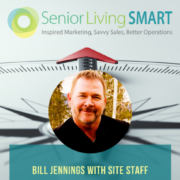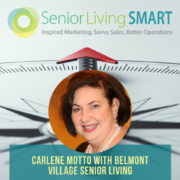Senior Living Marketing Perspectives: The Secret Sauce for Successful Live Chat
Topics Discussed and Key Points:
- SiteStaff Chat’s edge over other conversion services
- The two types of prospects that chat support representatives typically engage with
- How SiteStaff’s engagement specialists conduct conversations with prospects
- The importance of earning the right to ask for a prospect’s personal information
- Why Bill is passionate about empathy and culture
Episode Summary:
In today’s episode, Debbie speaks with SiteStaff Chat Founder Bill Jennings on how prospects for senior living facilities engage with Chat’s online support staff. Bill founded his company as a response to the many other support services that have the unfortunate tendency to offer generic, information-laden responses to website visitors. Instead, SiteStaff Chat’s approach is that of “an emotional selling process; making people feel comfortable.” This approach turned out to be the perfect fit for the senior living industry, of which the emotional component is naturally higher among prospects.
SiteStaff Chat typically sees two types of customers. The first type are family members looking for a place for their aging parents, but have little to no idea what to expect from or how to go about the process of moving them into a senior living facility. The second type are those looking to move themselves into a facility simply because they are looking for community and, of course, assistance. In both of these cases, support staff need to be both empathetic and understanding as they work to dispel prospects’ common fears while guiding them towards a decision.
Chat’s engagement specialists are looking to provide real answers to prospect queries, as opposed to canned ones. Bill laments the “copy-paste” tactics of traditional services, where answers are scripted and superficial. Chat aims to qualify the prospect, not by attempting to methodically close them, but by “humanizing the experience”, first by establishing whether there’s even a fit for them in the first place, followed by diving into specifics around the prospect’s particular circumstances and goals.
Today, Chat’s representatives spend an average of eight and a half minutes chatting with prospects. These eight and a half minutes are not spent giving an elevator pitch, but on having real, human-to-human conversations that aim to earn the right to ask the prospect if they are ready for the next step of the transaction.
When much of the modern marketing world focuses on vanity metrics such as views, impressions, clicks, or website traffic, it is crucial for a company (and refreshing for prospects) to create personal experiences that give visitors real value. After all, senior living communities deal with high-intent prospects. By empowering these prospects to make informed decisions through meaningful conversations, any business can achieve more of the metric that truly matters: conversions.
Try SiteStaff Chat for 30 Days Free of Charge by visiting https://www.sitestaffchat.com/ or give Bill a call at (303) 349-4282






